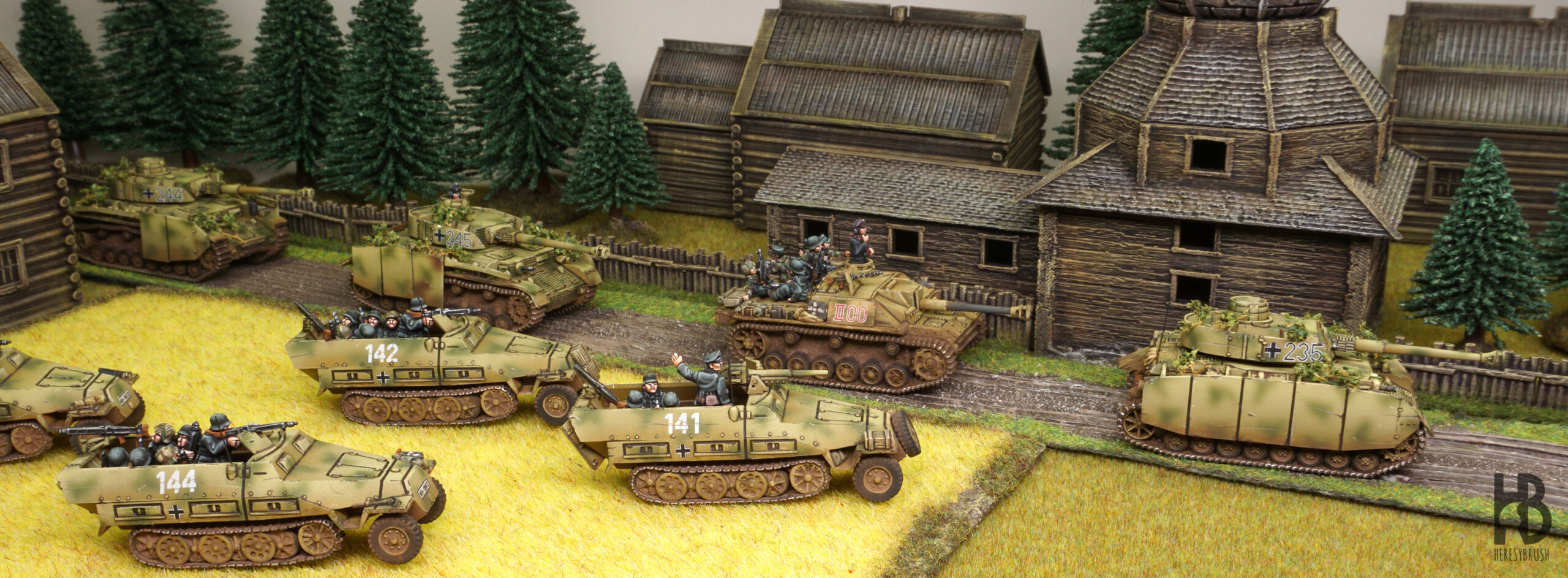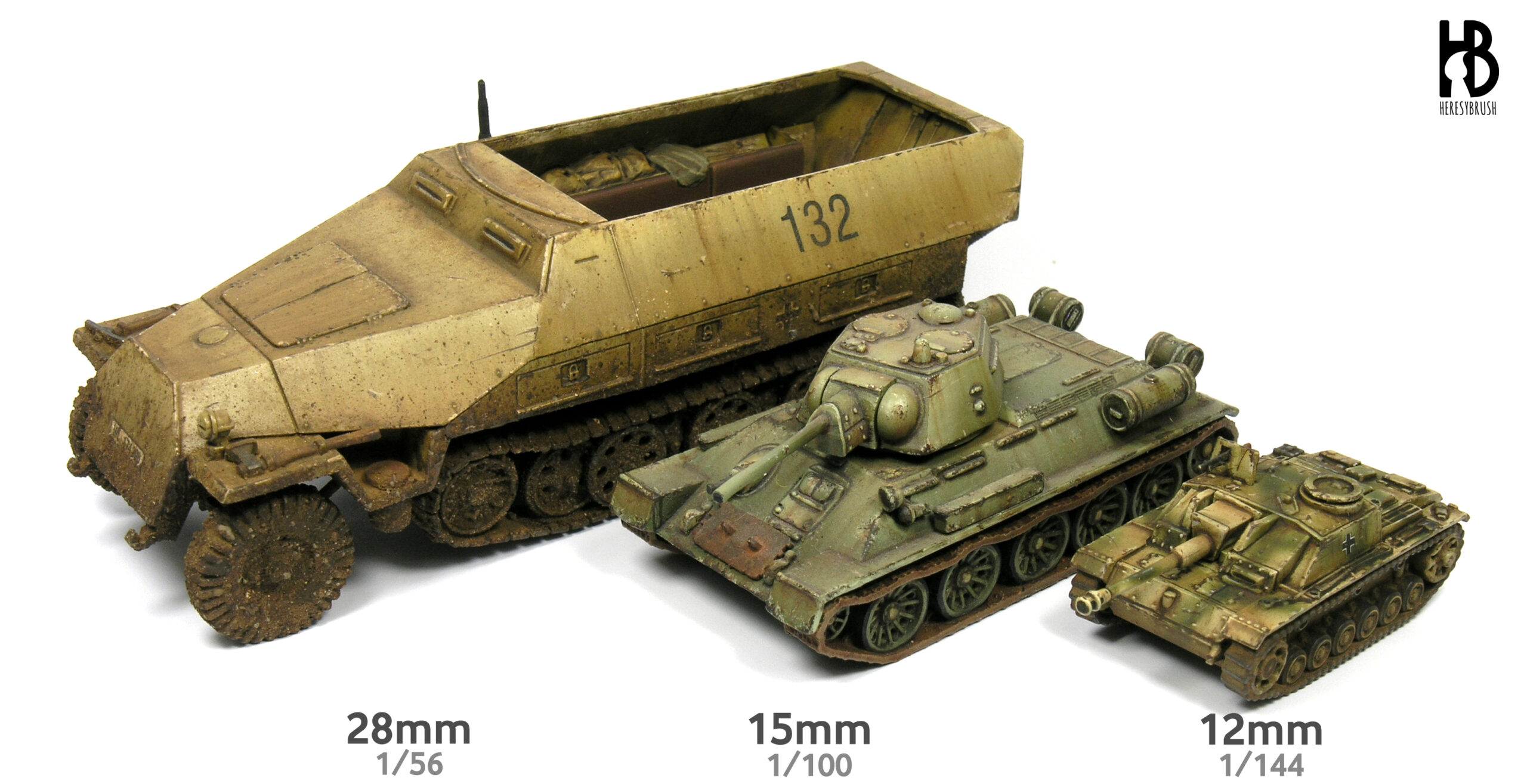In this article, we will explore how to create an anachronistic WWII camouflage, a “splinter camo”, commonly used by scale modelers for “what if” tanks and prototypes, such as the iconic German E series. To achieve this, we will use masking tapes to create an intricate tri-tone camouflage, where each color is carefully highlighted to create a striking contrast. This article was originally published on the Battlefront website, Part 1 and Part 2. The “What If” tanks open up endless possibilities for experimenting with color schemes and camouflage. Since these tanks never existed, the creative freedom is limitless. However, it…
How to quickly paint WWII German vehicles in 15mm
Here, I will describe the ‘speed painting’ method I started using last year to paint two full German armies for Flames of War. Speed painting is a relative term—what might be fast for me could differ for another painter. I consider this method fast because I simplified certain techniques compared to my traditional painting method, like color modulation, and omitted others entirely, such as using oils to create streaking or dust effects, which saved a lot of time. For this project, we will be using either the ATOM acrylic paints or the new IONIC acrylic paints for WWII German Tanks,…
How to create urban rubble bases
In a couple of weeks, I will be attending the Flames of War National tournament in Finland (Talvisota 2024), for which I have spent the last few months assembling a new German army. Given that the theme of the army is Berlin, 1945, I wanted to craft something unique for the bases of the infantry and Flak 88 guns. In this tutorial, I will demonstrate how to create urban bases with debris in a straightforward, efficient, and effective manner. While this tutorial primarily targets 15mm miniatures (Battlefront), its principles are adaptable to other scales or projects with the simple adjustment…
How to create autumn-themed bases
It has been a bit since my last blog post, but that does not mean I have forgotten about it. I am working on some neat stuff that I hope will be ready to share soon. In the meantime, I have put together a short and simple article explaining how we can create bases using simple materials while still achieving very realistic results. The trick is to utilize natural elements, such as soil and small branches. We save time because we do not need to paint them, plus they look precisely how they are supposed to on our tiny models.…
Improving a 15mm paint job: guns and crew
Most popular painting techniques for wargames fall in the category of fast painting methods that aim for the so-called “tabletop quality”. The idea is to have ready a unit or an army as soon as possible, with each miniature painted with the right colors and a bit of contrast between shades and highlights. These quick methods are perfect for wargamers since they do not require much time, allowing the players to spend more time in the battlefield. But, sometimes we have some extra time that we can use to push forward the quality of our miniatures for wargames. I would…
How to store our figures with Feldherr
This post is a little bit different compared with what I normally discuss in the blog, but still it covers a very important part of our hobby: how to transport our painted figures safely and comfortably (for us and for them). Yes, I do not only paint, but I also play! (not as much as I would like, I have to say). I use to keep my miniatures in a showcase with glass doors at home, where they are protected from the dust and I can easily have a look at them if I wish (strangely, I find it very…
How to paint 12mm (1:144) WWII tanks
During the last weeks I have been painting several dozens of tiny WWII tanks in 12mm (1:144 scale) produced by Victrix Games, a new branch of Victrix Limited. I thought that my preferred scale for tanks was 15mm, but these lovely beauties took my heart. In spite of the small size, the level of details is outstanding and they permit a 1:1 level of game (= bigger battles). And thanks to Victrix Games, now you can download totally for free a painting tutorial for each tank model. Each guide includes a complete step by step, with plenty of photos…
How to paint armed civilians in WWII
As I already commented in my previous post, I had the great opportunity to paint the wonderful new 28mm range from JT Infamous featuring the WWII Polish Home Army and perfect for Bolt Action.We already saw how to paint step by step the armoured truck Kubuś, and today we will see how to paint the soldiers (or civilians). Thanks to JT Infamous and Wargames: Soldiers and Strategy you can download for free two detailed step by step painting guides showing how to paint a Civilian armed with a Molotov cocktail and SMG (originally published in WSS 101) and another civilian dressed with stolen…
How to paint the WWII Polish Kubuś armoured car
I recently had the opportunity to paint the wonderful new 28mm range from JT Infamous featuring the WWII Polish Home Army, which includes a very charismatic armored soft-skin, the Kubuś. The range includes a mixture of fighters wearing civilian and military garments that results in a very colorful army. If you are planning to start a new Bolt Action army, have a look at JT Infamous website! Thanks to JT Infamous you can download for free a detailed step by step painting guide showing how to paint the Kubuś using acrylic and enamel/oil paints from AMMO: And stay tuned: soon…
How to paint WWII Polish infantry and Uhlans in 28mm
With the support of Kromlech Historical miniatures, I would like to share with you two painting guides where I show how to paint the WWII Polish uniform: an infantryman and a Uhlan. The former covers a soldier equipped with a great coat and the common steel helmet wz. 37 (or 1937 pattern), while the latter is divided into two parts. First, I explain how to paint dark bay horses, and then I show how to paint a Polish Uhlan (rider) equipped with a wz. 1936 jacket and Adrian-like helmet. For those who does not know Kromlech, this is a Polish…









